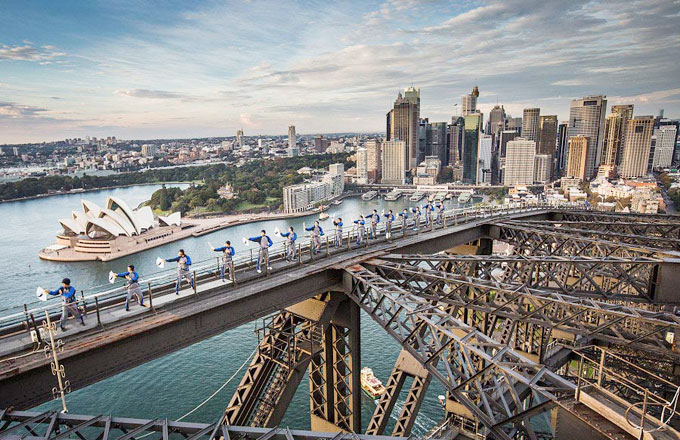

Environment
There is an understandable sense of urgency about Qatar's response to both global and local environmental issues. The country has a desert climate and an expanding economy so it faces pressing questions related to food and water supply on top of the challenge of developing a sustainable future. At present almost every item on the nation's dinner plate has to be imported.
In its ambitious plans, set out in the National Vision 2030, Qatar has made careful environmental development one of its four priority objectives.
Climate change threatens Qatar's habitat, food, water, and health in many ways. As a low-lying, coastal dryland nation it is totally reliant on desalination of sea water for freshwater. Qatar is among 10 countries in the world that would be most affected by a rise in sea level. Like many emerging nations, Qatar is striving to balance unprecedented growth and rapid progress with a desire to find and implement more sustainable solutions.
The Qatar National Food Security Programme plans to reclaim salty land, use technology and smart water management to grow an increasing proportion of its own food requirements. In 2012 the programme set itself a target of providing 40 per cent of its food needs within Qatar.
Through its research institutions, such as the Qatar National Research Fund, the Qatar Environment and Energy Research Institute, and Qatar Science and Technology Park (QSTP), Qatar is finding solutions for the problems that threaten the health of our environment.
The impact industry is being addressed through reductions in gas flaring at drilling sites and through carbon capture and storage.Flaring and venting of natural gas is practised in oil and natural gas industries around the world. Both are key targets for tackling climate change.
While energy production in Qatar increased by12 per cent between 1995 and 2008, flaring levels rose by only 2 per cent during that period and have remained stable since 2005. The net effect is a 10 per cent decrease in flaring per unit of production. Between 2009 and 2010, Qatar reduced flare volume by 14 per cent, down from 2.2 billion cubic metres in 2009 to 1.9 billion cubic metres in 2010.
With regards to carbon capture and storage (CCS), Qatar is investing heavily. CCS is a key means of reducing the emissions associated with fossil fuels and may be essential in addressing climate change while ensuring an adequate supply of energy for the world. CCS is likely to be able to avoid about 90 per cent of carbon dioxide emissions produced during the combustion of natural gas to generate electricity.
Advancing Renewable Energy
Solar energy is a valuable renewable resource in Qatar, and it may become a major resource for meeting Qatar’s long-term energy needs while also helping to reduce the country’s greenhouse gas emissions. Qatar’s Investment Authority was the first to confirm the country’s investment of $240 million into the UK $400 million venture capital fund for renewable energy projects. This partnership demonstrates Qatar’s interest in enabling clean, renewable energy globally, as well as at home.
Qatar has launched a number of domestic projects that seek to harness the power of sunlight. Among them, the 35,000-squatre metre Solar Test Facility is a world-class project between Qatar Science and Technology Park, GreenGulf, and Chevron to test new and emerging solar technologies from around the world.
Protecting the land
In protecting its natural environment, Qatar has strong policies in place, led by the Ministry of Environment. In Qatar, 22 per cent of the land is designated as a protected area. This far exceeds the 10 per cent stipulated by signatories to the Convention on Biological Diversity, of which Qatar is a signatory.
Qatar's five main protected areas include important areas with wildlife and biodiversity, as well as coastal areas. This includes Al-Dhakira, where the mangroves are important both for biodiversity, marine breeding grounds and for their high carbon-sequestration rates. Other inland protected areas serve as vital breeding grounds for animals such as the Arabian oryx, and for rare plants, such as the rimth, or Haloxylon salicornicum. The Arabian Oryx, for example, was the first animal to receive ‘vulnerable’ status again after being listed as extinct in the wild by the International Union for Conservation of Nature, in large part due to Qatar’s policies.
Qatar has several wildlife initiatives including banning camel grazing, which can be harmful to plant growth; reintroducing and protecting threatened fish species and their coral habitats; monitoring and protecting seasonal sea turtle breeding grounds; and monitoring and protecting the migratory patterns of the dugong sea mammals.
Many of Qatar's educational and development organisations are also taking bold steps towards preserving the environment. Since 2007, Qatar Foundation has mandated that no new building can be constructed in its Education City unless construction abides by strict green building codes.
And the green word is spreading. Some shops are planning to give away recycled shopping bags in an effort to persuade people to re-use a bag and cut down on the use of plastic.
Key Facts Qatar’s annual rainfall: 74 millimetres Qatar’s land designated as protected land: 22 % Qatar’s energy target from solar energy by 2018: 10 % Total global carbon emissions attributed to Qatar (as of 2006): 0.2 % Proportion of food to be produced in Qatar by 2024: 40%












